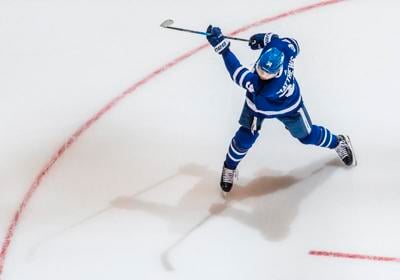When it was mentioned to Devan Dubnyk that Maple Leafs centre Auston Matthews was trying to add a one-timer to his already dangerous arsenal of shots, the Minnesota Wild goalie just laughed.
āTrying to develop one?ā said Dubnyk. āI donāt know if thatās the right way to put it. Iāve seen him hit a couple. I think heās developed it.ā
Matthews went into Wednesday nightās game against the Washington Capitals leading the Maple Leafs in goals with seven, a number that ranked him second in the NHL behind James Neal of the Edmonton Oilers. The 22-year-old been a dangerous scorer throughout his early career, but thinks he can be even more dangerous if he can get that one-timer to connect.
āI think itās all right,ā said Matthews. āStill getting a feel for it. Itās a lot harder of a shot than you think of. You watch guys like Ovie and Stammer and Laine (Alex Ovechkin, Steven Stamkos and Patrik Laine) and they just tee it up and itās going in their spot every time. It really is a tough shot and something Iām trying to improve on it.ā
Matthews has scored twice with his one-timer, in the first two games of the season. Mitch Marner is trying one out too, though Matthews has the harder shot. Both are set plays on the power play.
Andreas Johnsson scored on one, too, thought it was more a reaction off a rush, and ditto John Tavares, who net one against Dubnyk on Tuesday night.
āItās good for us to see that and try to improve in that area,ā said Matthews. āEspecially on the power play, trying to open up that seam and open up those areas for us that we can get that one-timer off.ā
Think one-timer in the NHL and you think Ovechkin, the Leafsā foe on Wednesday night.
According to Bruce Boudreau, who coached the Russian in Washington from 2007-11, no NHL player that heās ever seen has had a one-timer like Ovechkin.
Boudreau, of course, played in the wooden-stick era, a time when sticks didnāt have the bendability or flexibility of todayās sticks that have made the one-timer so dangerous for those who can perfect it.
But Boudreau did say that when Ovechkin scored 32 goals during the 2010-11 season ā his lowest mark in an 82-game campaign ā it was because he had switched sticks to one that was less flexible and broke a lot. The scoring returned when he switched back.
āWhen he (Ovechkin) hits it right on, the goalie is saying: āHit me or itās in,āā said Boudreau. āThatās why is going to challenge Wayne (Gretzky) when itās all over for the most goals ever. Itās a phenomenal shot that heās got and heās great at it.ā
Gretzky set the standard of 894 career goals in the regular season, with Ovechkin the active leader sitting 13th overall at 663 heading into Wednesdayās action. If he catches Gretzky, it will be in large part because of his one-timer.
Thereās no question that Matthews admires Ovechkin ā and other players who do it well.
Matthews worked on it over the summer knowing heād be a left-handed shot on the right side during the power play, a switch from his first three years in pc28¹ŁĶųand a switch that lends itself to the one-timer.
āI wish him luck,ā Ovechkin told reporters in Washington on Wednesday while joking about the curve of his stick. āIt looks easy, but itās not. You have to find the right spot, you have to shoot the puck in the right spot. If it goes in, it goes in. If not, keep going.
āYou have to find the right spot for you. Then your body, your arms and everything has to be 100 per cent. Then it hits your stick and you feel it right away. If it goes hard and goes to the spot you want, itās hard to stop.ā
Ovechkin scored 20 per cent of his goals, according to , as a right-handed shot on the left side of the ice.
āItās a hard shot,ā said Matthews. āI never really took them before. This year, obviously we switched (the power play around) and I tried to work on it over the summer. Itās not easy.
āIt gives you an appreciation for the guys that have been doing it for quite some time and the guys who made it their trademark, guys like Ovie and Stammer and Laine as well. Guys that can really just pick the corner.ā
The one-timer works best if the pass comes from the other side of the ice, getting the goalie to move across his crease.
āThe biggest thing is you want to make sure that you have your eyes on the puck all the time,ā said Dubnyk. āBecause if you can get over there and get set, youāre going to give yourself the best chance to stop it.
āYou run into trouble if you if you allow yourself to lose sight of the puck before the pass comes, and you only pick up the pass maybe halfway and then youāre trying to catch up to it. Thatās usually when holes open up and they can get it by you.ā
Whatās the key for Matthews?
āJust timing. Then accuracy.ā



























To join the conversation set a first and last name in your user profile.
Sign in or register for free to join the Conversation